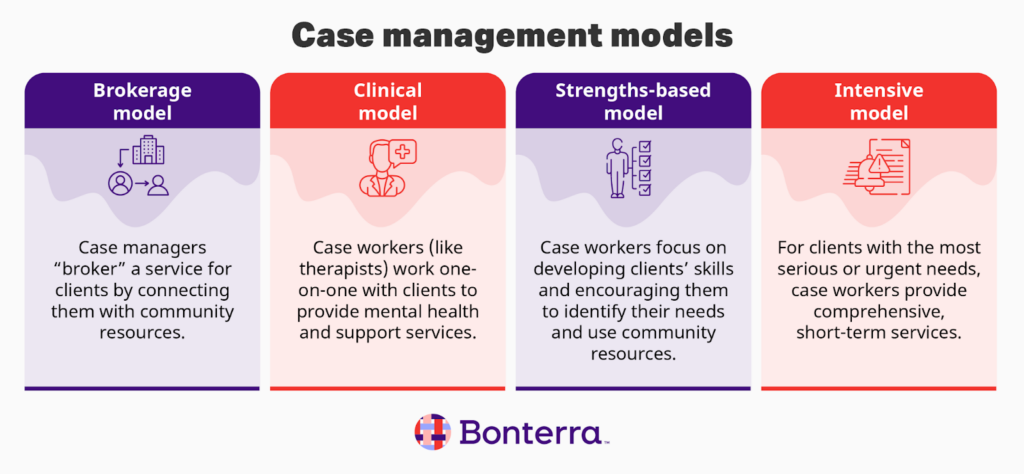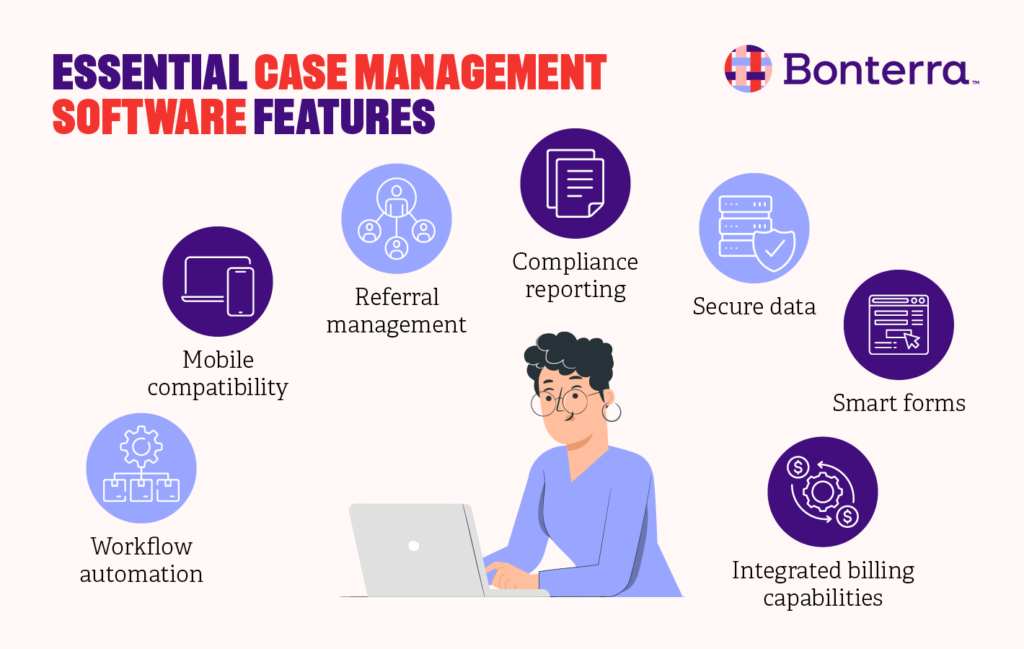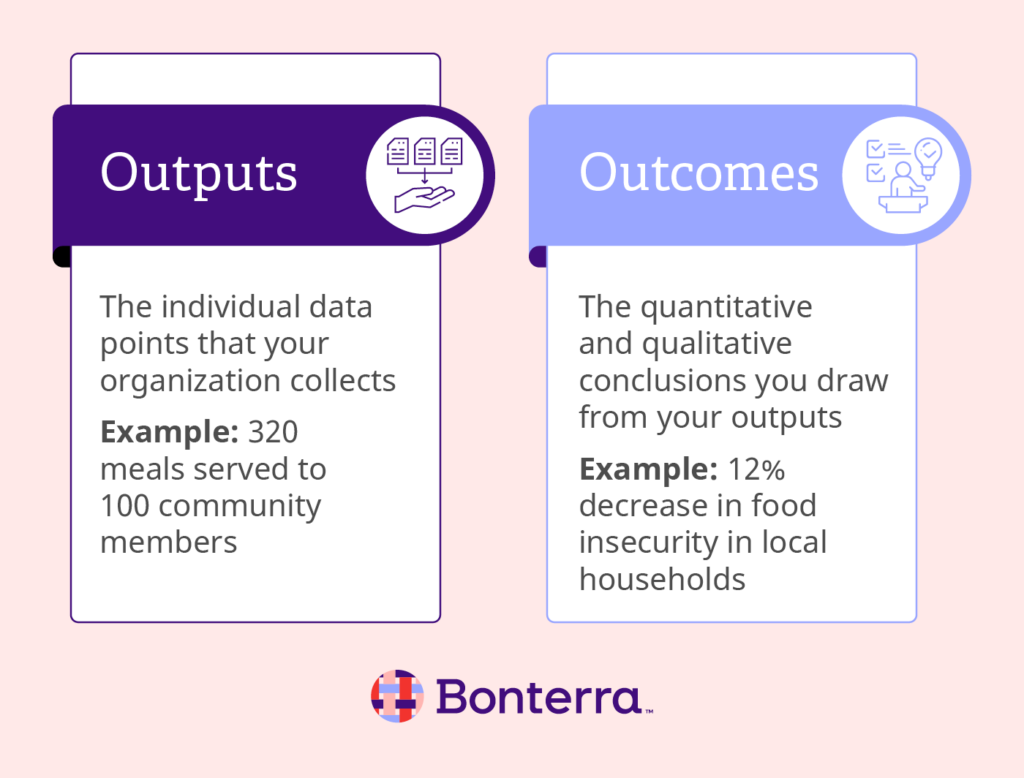7+ case management strategies: How to make an impact

Nonprofit organizations and public sector agencies in the healthcare and human services fields do the important work of providing individuals with the services they need on a case-by-case basis. A strong case management process can streamline this vital work and allow these organizations to allocate their resources effectively.
Fortunately, whether your organization has an established process or is currently developing one, there are case management software and strategies you can implement to provide care more efficiently, improve outcomes, and grow your organization.
In this guide, we will explore top case management strategies any nonprofit or public sector agency can use. First, let’s establish a solid definition of case management to provide a frame of reference.
What is case management?
Case management is the process of working with a client in need of health and human services to assess their needs, create an improvement plan, and monitor their progress. Usually, case workers assist clients on an individual basis to provide them with tailored care that adapts to their changing needs and circumstances.
Before going any further, it is necessary to note that case management comes in several models that have unique service processes. These models include:

- Brokerage: Rather than providing services themselves, the case worker serves as a broker, referring clients to external services and community resources.
- Clinical: In the clinical case model, case workers refer patients to professional clinical services while also providing individualized care and support. For example, a therapist might refer a client to a psychologist for additional mental health services while continuing to have routine sessions with the client to provide mental and emotional support.
- Strengths-based: Instead of referring clients, the strengths-based model involves providing services to the client directly and focuses on empowering the client to develop skills, identify their own needs, and seek out community resources.
- Intensive: If a client has intense or urgent needs, the case manager might opt for an intensive model approach. In this model, case managers take immediate actions to provide concentrated services until their situation improves and the case worker’s usual case model approach is applicable.
The case model used depends on the organization type, the case worker’s process, and the client’s needs. For example, the intensive model can appear at almost any organization if a client has severe needs while the clinical and brokerage models are mutually exclusive.
Case management strategies
1: Build relationships
Many clients seek out your services when they are struggling with difficult, deeply personal situations. As such, while clients want help, many may hesitate to work with or even trust their case manager at first.
To provide comprehensive care and ensure you don’t overlook any of the client’s needs, case managers must strive to build relationships with their clients. This doesn’t mean becoming friends with clients but rather developing a rapport where the client feels comfortable confiding in and trusting their case worker.
While every client is different and case managers should adjust their approach based on the client’s unique situation, you can lay the groundwork for positive client relationships by practicing the following:
- Active listening: One of the first steps in the case management process is assessing a client’s needs. By practicing active listening, case managers can give clients the space they need to express themselves. While case managers may have a set number of required questions that need to be answered, they should also use the information the client shares with them to tailor their questions to the client’s unique circumstances.
- Confidentiality: Many clients share sensitive details with their case workers, so it’s important to ensure clients know that they can confide in them without fear of their information getting out.
- Empathy: Your clients will come from all walks of life, and due to their circumstances, some may be easier to connect with than others. For example, a case worker assisting foster children might have clients who misbehave due to their stressful circumstances. However, it is the case worker’s job to treat all clients with respect and empathize with their situations. This means being non-judgmental, showing compassion, and validating each client’s experiences.
By building a relationship with clients, not only will clients trust their case managers but case managers will also learn more about their clients’ unique preferences. This allows them to provide personalized action plans and identify potential obstacles and opportunities.
2: Record all interactions
Every time a case worker meets with a client, it should be recorded. By documenting interactions with clients, you can gather comprehensive notes and ensure you don’t miss anything important.
Recording interactions will look different depending on your organization type. For example, some case workers, such as therapists, take detailed notes about their conversations with their clients. Others may simply make small notes and record that a meeting took place in the client’s file.
To keep an organized record of all interactions, consider investing in case management tools. Case managers often juggle many clients and multiple programs, and it can be easy to lose specific forms or forget to log a session with a client if all documentation is done on pen and paper. With case management software, you can simply open a client’s file to record meetings and will easily notice if an entry is missing. Plus, some case management software has alert features and reminders to ensure all meetings get documented.
3: Collaborate with your team
Often, health and human services cases are complex and require multiple providers to work together to provide clients with the support they need, making collaboration essential. From working together to brainstorm solutions to managing administrative work, open collaboration saves time and improves results for clients.
For instance, where possible, try implementing closed-loop referrals. When a case worker refers a client to another service, they don’t receive updates from the referred organization. This makes it difficult to know if the client received adequate support or even followed the referral at all.
With closed-loop referrals, providers have multi-directional communication, allowing them to share information about clients and take a holistic approach to their care. To build closed-loop referrals, research if there are already networks in your community related to your services that you can join. If not, your organization can take the first step to building a network by approaching providers you regularly work with to discuss communication and follow-up strategies.
4: Create a task management strategy
Case managers have several clients, deadlines, and high-priority tasks at once, and it’s easy to get in a situation where you’re putting out fire after fire. Prevent this by spending the time to create a dedicated task management strategy.
A few ways to help yourself and your team stay organized include:
- Setting reminders: Use your case management software to set reminders for various tasks. For example, you might set up a reminder for completing your organization’s compliance report to go off two weeks prior, a week before, and on the day the report is due to ensure you stay on track and don’t miss the submission deadline.
- Establishing a priority system: When a new task arrives on your schedule, give it a priority ranking. For example, you might mark high-priority tasks as red, medium-priority as yellow, and low-priority as green. This allows you to assess your daily schedule at a glance to see what absolutely needs to get done and what you could push to a less busy day. Remember to add a deadline for even low-priority tasks so they don’t just get repeatedly moved back.
- Creating a calendar: If you don’t already have a calendar organizing your day-to-day tasks, create one. A color-coded calendar lets you visualize your schedule and move tasks around as needed to ensure you hit deadlines but also avoid burnout.
On the topic of avoiding burnout, consider varying the tasks you tackle. Case management is often emotionally draining, so keep yourself engaged and motivated by focusing on a few simple tasks in between major ones.
For example, you might complete a few simple referrals after a difficult meeting. This will help you feel productive and ensure tasks that can be completed quickly don’t get pushed back because they are lower priority.
5: Invest in case management software
Case management software can significantly streamline and improve your organization’s ability to serve clients. These tools centralize information to make collaboration easier and ensure no documents ever go missing.
When it comes to case management software, we offer one of the most comprehensive, flexible, and user-friendly solutions available. Here’s an overview of some of the top features.

- Workflow automation
- Mobile compatibility
- Referral management
- Compliance reporting
- Secure data
- Smart forms
When assessing case management software, consider your organization’s needs and budget. Solutions for case management have multiple pricing options to better meet small and medium-sized organizations’ needs. You might decide your organization doesn’t need forms with smart entry fields but that intuitive compliance reporting tools are a must.
6: Make evidence-based decisions
Your standard case management process can take you far, but clients often need individualized care that you need to plan out yourself. To make effective decisions for each client, ensure your team has the tools they need to make evidence-based decisions when service planning.
Encourage case workers to use your case management software to assess their notes and your program outputs at any time. For example, a case worker might notice that a specific program serves most clients well but individuals with a specific condition tend to have poorer results. This insight could allow them to plan a modified approach based on their knowledge of their client.
7: Give the client goals
It’s easy to view case managers as giving care to clients and clients passively receiving help. However, this way of thinking doesn’t encourage clients to take an active role in their own progress, potentially limiting skill development and success after exiting your program.
Avoid this scenario by making clients partners in their improvement plans and giving them specific goals to accomplish between meetings. Be sure these goals are specific and viable based on the client’s current situation. For example, many case workers might give clients an initial goal of reaching out to a referral. This task is small but encourages the client to continue seeking care and practice asking for help.
Add client goals to your action plan and link each goal to your overall objective of helping the client be healthy, secure, and happy. This will help clients understand why seemingly small goals are important, incentivizing them to continue following through and completing them.
8: Evaluate outcomes
To drive better results for your organization as a whole, ensure you’re assessing outcomes rather than just outputs. Outcomes and outputs are both important but measure different aspects of your organization’s results. Here’s a breakdown of these terms:

- Outputs are the data your organization collects related to your program’s results. For example, an organization dedicated to helping unhoused individuals find permanent housing might report the output of sourcing affordable housing for 100 people every year.
- Outcomes are the long-term results of your programs that can be determined by analyzing your outputs. For example, the previous organization might report an outcome of reducing homelessness in their city by 5% and providing clients with long-term skills to prevent becoming homeless again.
To measure outcomes, you need mature data collection and management practices that allow you to track outputs and analyze them. For many organizations, this will involve investing in case management software. When you adequately track interactions with clients, you’ll already have the data you need to assess how many clients you serve, if your services are benefiting them, and what the long-term results of those services are.
Consider also taking a deep look into specific programs by creating impact reports. These reports take a deep look at individual programs and are usually compiled to present to funders. If your organization has received grant funding or needs to present your impact to other stakeholders, creating an impact report may be a necessity.
Streamline your case management strategies with Bonterra
Case management strategies ensure your nonprofit or public sector agency doesn’t just move clients along through the case management process but actually engages with them, stays organized, and analyzes programs to make targeted improvements.
To start enacting these case management strategies, we recommend taking the step of investing in case management software, like Bonterra Apricot.
Ready to improve your impact reporting with Bonterra Impact Management?
Case Management
Work with Bonterra



